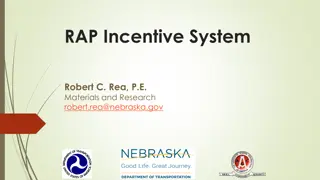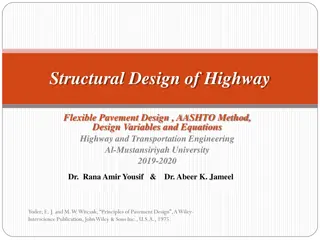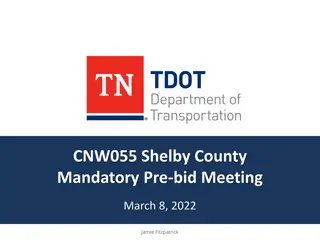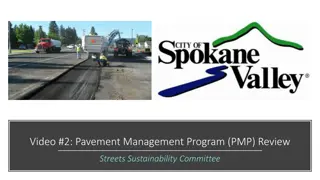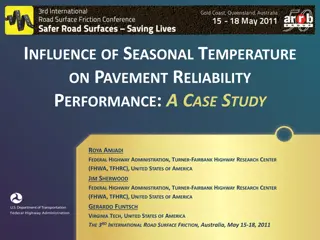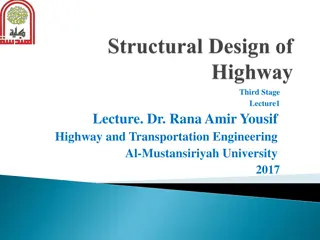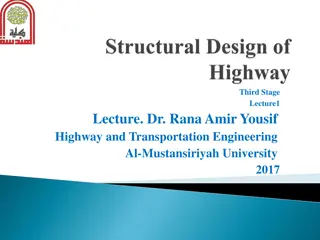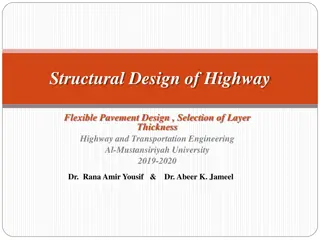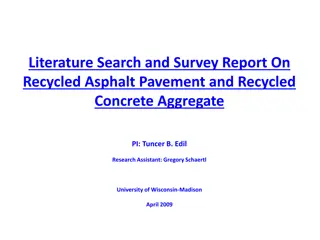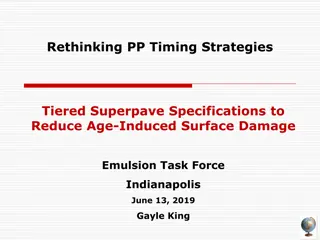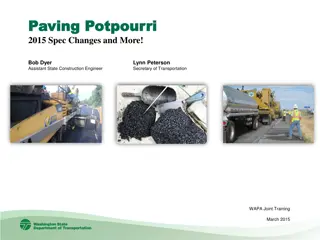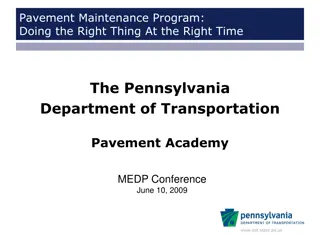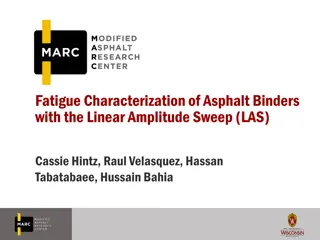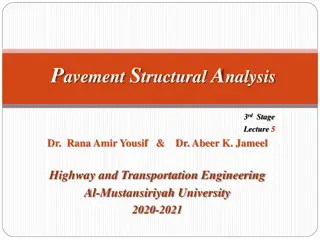Understanding Asphalt Binders in Pavement Construction
Asphalt binders play a crucial role in pavement construction, composed of three types of hydrocarbons: asphaltenes, resins, and oils. Different types of asphalt cements are produced for specific applications, such as liquid asphalts and asphalt emulsions. Quality control tests ensure the performance of asphalt, with standards like Superpave improving pavement durability. The Strategic Highway Research Program (SHRP) drives advancements in highway infrastructure through collaboration with industry stakeholders.
Download Presentation

Please find below an Image/Link to download the presentation.
The content on the website is provided AS IS for your information and personal use only. It may not be sold, licensed, or shared on other websites without obtaining consent from the author. Download presentation by click this link. If you encounter any issues during the download, it is possible that the publisher has removed the file from their server.
E N D
Presentation Transcript
Asphalt Cement contains 3 types of hydrocarbons: 1. Asphaltenes - large, hard, black material 2. Resins - surrounds asphaltenes helping ductility 3. Oils - suspends resins allowing asphalt to flow
Asphalt cements are produced by distillation of crude oil. Asphalt material is graded by its viscosity at different temperatures.Common to this area are AC-10 and AC-20.
Asphalt Cements - AC-10,AC-20, ect. used to produce asphalt pavement Liquid Asphalts - cutback with a solvent then sprayed on material; solvent evaporates leaving behind stiff surface
Asphalt Emulsions - asphalt cement mixed with soap and water, then sprayed on material. Water evaporates leaving a stiff surface. Environmental friendly compared to Liquid Asphalts.
Quality Control Tests for Asphalt: Viscosity - ASTM D2171,D2170,E102 Penetration Values - ASTM D5 Ductility - ASTM D113 Thin-Film Oven Test - ASTM D1754 Solubility - ASTM D2042 Flashpoint - ASTM D92
Strategic Highway Research Program (SHRP) SHRP started in 1987 to improve highways SHRP is a unit of the National Research Council cooperating with the Federal Highway Administration (FHWA) and the American Association of State Highway and Transportation Officials (AASHTO)
Highway operations Concrete and structures Asphalt Long-term pavement performance
The standards developed by SHRP are called Superpave standards, for SUperior PERforming asphalt PAVEments. SHRP changed the name asphalt cement to an asphalt binder because of the modifiers mixed with the asphalt. The grade of asphalt binder is tied to the average high and low temperatures of the region.
Example: PG 58-28 is for areas with an average maximum temperature of 58 and a average low of -28 .
New tests for Superpave: Rolling Thin-Film Oven Test (RTFO)- measures short term aging Pressure Aging Vessel Test (PAV)- measures long term aging Rotational Viscometer Test -measures viscosity at high temperatures
New tests for Superpave: Dynamic Shear Rheometer Test - test elastic and viscous properties at different temperatures Bending Beam Rheometer Test - resistance to cracking at cold temperatures
1. Produce aggregates to meet specifications 2. Run trial batches at different oil contents 3. Trial batch tested for compliance to specs 4. Repeat if necessary
Marshall Method: 1200 grams of mix is placed into 4 mold Hammer is dropped 50 times Turn over and hammer 50 times Repeat for at least 3 pucks
Marshall Method: Test pucks for: o Flow and Stability o Density o Air Voids
Creative Commons License This work for Mapping New Careers in Geospatial Technologies is a derivative of "AEC 212-Soils Mechanics" by Aims Community College used under CC BY 4.0 and is licensed by Mapping New Careers in Geospatial Technology under a Creative Commons Attribution 4.0 International License. This workforce solution was funded by a grant awarded by the U.S. Department of Labor s Employment and Training Administration. The solution was created by the grantee and does not necessarily reflect the official position of the U.S. Department of Labor. The Department of Labor makes no guarantees, warranties, or assurances of any kind, express or implied, with respect to such information, including any information on linked sites and including, but not limited to, accuracy of the information or its completeness, timeliness, usefulness, adequacy, continued availability, or ownership.




